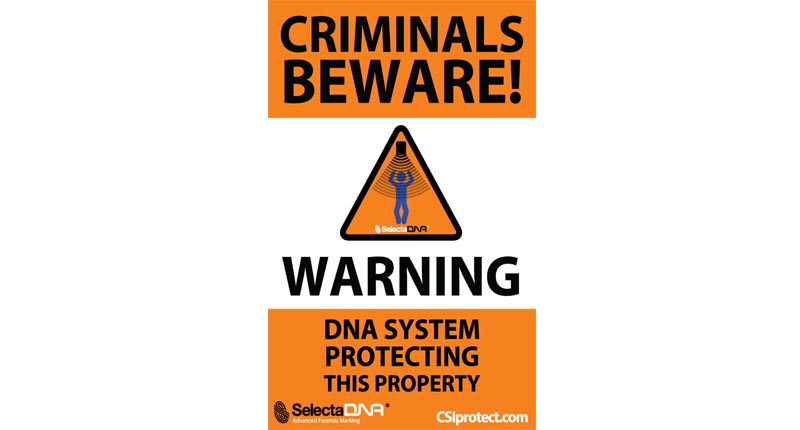Consumers shared concerns about prices, inflation, tariffs, trade, and politics in the survey’s write-in response section.
To Catch a Thief, There’s DNA Spray
The Intruder Spray System is used in banks and convenience stores in Europe, and now has been installed in a high-end watch boutique on New York’s 57th Street.

New York—The company behind the fine, harmless mist that’s been deployed to deter and detain thieves in Europe for a decade is making a push into the U.S. market.
SelectaDNA’s Intruder Spray System (ISS) uses forensic markers, or DNA, but not the same kind police use to crack the cold cases featured on “Dateline” or that led to the arrest of the man believed to be the Golden State Killer after three decades.
What’s used in ISS is synthetic DNA that, just like human DNA, can be used to tie suspects to a particular place and time.
Installed at points of entry and exit, the system works by spraying the perpetrator or perpetrators with a fine, non-toxic water-based mist dispensed from a canister that’s about the size of a standard aerosol cleaner or beauty product.
The canisters can be installed anywhere—above doors, by windows, in ceilings, in walls, or in the ground—and the spray is triggered in a number of ways, said Joe Maltese, who is handling sales and marketing for SelectaDNA in the United States.
It can be integrated with a store’s security system or wired to its motion detectors so it hits people who trip the alarm, or activated manually via panic buttons or money clips, meaning jewelers who are in the store during a robbery can press a button to spray the perpetrator on his or her way out.
A high-tech version of the dye packs invented in the ‘60s to foil bank robberies, the spray marks the suspect with an invisible, odorless substance that stays on his or her skin for 4-6 weeks and on clothing for a bit longer, up to three months.
If the suspect is taken into custody during that time, the mist will show up under a special-frequency ultraviolet light. Police can then take a swab and send it to the SelectaDNA lab for analysis.
Maltese explained that the spray in each canister has its own long, unique code that’s used only once, so when the lab receives a swab, it can say with 100 percent accuracy that particular spray
“It’s impossible that they [the suspects] were not there because that code is never used again,” he said while pointing out that the forensic marker is used in concert with other evidence, such as first-hand accounts and surveillance video, to help prosecute suspects.
The cost varies depending on the size and complexity of the system, but Maltese said plans start around $80 a month. There is also a $240 fee to replace each canister. The canisters must be replaced every time they’re activated, or once a year if they haven’t been used.
WATCH: The Intruder Spray System in Action
SelectaDNA’s Intruder Spray System, which is distributed through CSI Protect in North America, is used in 46 countries by banks, fast-food chains, convenience stores and jewelry companies including TAG Heuer, Pandora, Chanel, and Watchfinder & Co.
Originally piloted in the U.S. market in 2015, ISS is currently installed in five places here: a rare book store in Florida, two convenience stores, one major national retail chain Maltese said he can’t name because of a non-disclosure agreement, and one watch boutique—the Richard Mille flagship on 57th Street in New York.
The high-end watchmaker is the first retailer in New York state to use it, marking the first adoption of the technology by a watch or jewelry retailer in the U.S., a market that SelectaDNA is looking to break into (no pun intended).
In a statement emailed to National Jeweler, Richard Mille said it learned of the system in Europe and found it to be a “worthwhile addition” to the new flagship location in Manhattan.
Questions & Answers
As with any security system, there are, of course, some drawbacks and questions about the Intruder Spray System.
No. 1 is awareness. Police have to be educated about the system so they know to look for the invisible film and have the proper equipment to detect it.
Maltese acknowledged that the company’s efforts to educate law enforcement agencies across the entire United States are akin to a “marathon;” they will be ongoing for years because of the size of the market. In New York, the company is working with the state sheriff’s association, and in Florida, they’re working with the Florida Law Enforcement Exchange.
Jewelers’ Security Alliance President John J. Kennedy described ISS’s adoption as a “long-term proposition.”
“[The system is] going to have to become accepted and widely used and the police are going to have to be knowledgeable about it,” he said. “There’s a big learning curve here.”
Kennedy brought up another concern he has with the system—the fear of retaliation from criminals if they realize they’ve been sprayed.
“When there’s nobody in the store, like in a burglary, it seems less risky; they won’t hurt anybody,” he said. “In a robbery situation, however, I just hope it doesn’t precipitate violence or retaliation.”
Maltese said criminals don’t notice that they’ve been sprayed, as they are usually charged with adrenaline and focused on one task—getting out of the store they robbed as quickly as possible. He added that there have been zero incidents of a criminal retaliating after being sprayed.
Kennedy said the JSA does not endorse any specific products or companies, but he did allow that he thinks SelectaDNA “has the best handle” on the DNA spray technology and are working with police departments and the industry in a “sensible way” to try to get it into jewelry stores and offices.
SelectaDNA is one of a fresh crop of companies popping up to pitch technology-based security solutions to the jewelry industry. It is a revival of the boom seen in the mid-1990s, before the dot-com bubble burst, that’s been made possible by the availability of startup money and advances in technology.
Kennedy said JSA is always on the lookout for new technologies that could aid with security and the rest of the industry should be too.
He said, “Retailers and other jewelers should keep abreast of things to see what will apply to their own businesses.”
The Latest

In February 2026, the auction house will move its headquarters to the former Steinway Hall, a neoclassical landmark on Billionaires’ Row.

The new show will take place Jan. 23-25, 2026.

How Jewelers of America’s 20 Under 40 are leading to ensure a brighter future for the jewelry industry.

The former BHP Billiton leader and Gemfields chairman is remembered for his influential leadership throughout his 50-year mining career.


The LVMH-owned brand has partnered with the costume design union to revamp its award for 2026.

The luxury titan inked a deal to acquire an initial minority stake in the jewelry manufacturer with a pathway to full ownership by 2032.

Roseco’s 704-page catalog showcases new lab-grown diamonds, findings, tools & more—available in print or interactive digital editions.

The company’s curation of unsigned vintage and estate jewelry debuted at the Bloomingdale’s in Costa Mesa, California.

Helzberg’s Chief Retail Officer Mitch Maggart shared details about its tests of a new store concept rooted in an elevated luxury experience.

Jewelers of America execs and National Jeweler editors discuss tariffs, the sky-high gold price, and the engagement that broke the internet.

The luxury goods company said founder Ippolita Rostagno will remain at the brand’s helm.

Laura Burdese, who joined the Italian luxury brand in 2022, will take on the role in July.

The National Jeweler editors revisit the most noteworthy industry happenings and design trends from 2025.

Need a gift for the cat lover who has everything? Look no further than our latest Piece of the Week.

It purchased the “Grosse Pièce,” an ultra-complicated Audemars Piguet pocket watch from the ‘20s, for a record-breaking price at Sotheby’s.

The lab-grown diamond grower now offers custom engagement and fashion jewelry through its Kira Custom Lab Jewelry service.

Chandler got his start at Michelson Jewelers and has served as DCA president and CEO since 2001. He will retire at the end of the month.

The boutique is slated to open this week inside Terminal 8, offering pre-owned Rolex watches and more to international travelers.

Sponsored by Digital Monitoring Products

The special-edition egg pendant ingested in a New Zealand jewelry store was recovered after a six-day wait.

Associate Editor Natalie Francisco plays favorites with Piece of the Week, selecting a standout piece of jewelry from each month of 2025.

The “Love and Desire” campaign is inspired by the magic that follows when one’s heart leads the way, said the brand.

Two awardees will receive free tuition for an educational course at the Swiss lab, with flights and lodging included.

Berta de Pablos-Barbier will replace Alexander Lacik at the start of January, two months earlier than expected.

Sotheby’s held its first two jewelry sales at the Breuer building last week, and they totaled nearly $44 million.

Winners will receive free registration and lodging for its fourth annual event in Detroit.


























